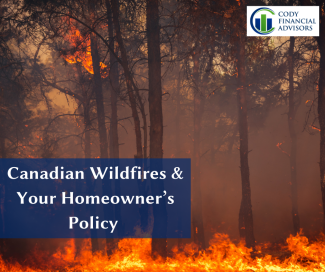
Canadian Wildfires & Your Homeowner’s Policy
Smoke damage is usually not covered under typical insurance policies
On June 7th, the heavy smoke from more than 400 Canadian wildfires was responsible for the air quality in New York City to be deemed the absolute worst in the world, as smoke was covering much of the eastern United States. In fact, close to 100 million people in 18 states from New Hampshire to South Carolina were under air quality alerts.
When it comes to protecting our homes, we often rely on homeowner's insurance policies to safeguard us against unforeseen events and damages. However, one aspect that is often overlooked is the coverage for smoke damage. Many homeowners are unaware that smoke damage is typically not covered under standard homeowner's insurance policies, leaving them vulnerable to potential financial losses.
Why Smoke Damage is Excluded
The exclusion of smoke damage from homeowner's insurance policies stems from several factors. Firstly, the complexity of assessing and quantifying smoke damage makes it challenging for insurers to provide comprehensive coverage. Smoke particles can infiltrate various surfaces, including walls, furniture, and electronics, leading to long-term damage and health hazards. Determining the extent of the damage and evaluating the costs for restoration becomes a complicated process.
Secondly, smoke damage is often considered a secondary effect of a primary peril, such as a fire. Insurers primarily focus on covering the primary perils themselves, such as structural damage caused by the flames. While smoke damage can be a significant consequence of a fire, it is generally treated as a separate issue that falls outside the scope of the standard policy.
Exceptions & Additional Coverage Options
While standard homeowner's insurance policies typically exclude smoke damage, there are some exceptions and additional coverage options available. Some insurers offer optional endorsements or riders that can be added to the policy to cover smoke damage explicitly. However, these additional coverages often come at an extra cost and may have specific limitations and exclusions.
It is crucial for homeowners to carefully review their policies and consult with their insurance advisors to understand the extent of coverage for smoke damage. Some policies may provide limited coverage for smoke damage resulting from a covered peril, such as a fire caused by lightning or a faulty electrical system. However, coverage for smoke damage resulting from wildfires or neighboring property fires is generally excluded.
Mitigating the Risks
While smoke damage may not be covered comprehensively by homeowner's insurance, there are proactive steps homeowners can take to mitigate the risks and protect their properties:
- Install Smoke Detectors: Ensure that your home is equipped with smoke detectors in all the necessary areas, including bedrooms, living spaces, and the kitchen. Regularly test and maintain these detectors to ensure their effectiveness.
- Fire Prevention Measures: Implement fire prevention strategies, such as proper storage and handling of flammable materials, regular maintenance of electrical systems, and safe practices in the kitchen. Minimizing the risk of fire can help reduce the potential for smoke damage.
- Consider Additional Coverage: If you reside in an area prone to wildfires or if neighboring properties pose a higher risk of fires, explore supplemental insurance options that specifically cover smoke damage. Discuss these options with your insurance provider to determine the best course of action.
- Document Your Belongings: Keep an inventory of your belongings, including photographs and receipts, to assist with the claims process in case of smoke damage. This documentation can help support your claim and facilitate a smoother resolution with the insurance company.
Planning Matters
Understanding the limitations of homeowner's insurance policies regarding smoke damage is essential for homeowners to adequately protect their properties and finances. While smoke damage may not be covered by default, homeowners can explore additional coverage options and implement preventive measures to mitigate the risks.
Regularly reviewing and updating insurance policies, consulting with insurance professionals, and maintaining a proactive approach to fire prevention can go a long way in safeguarding homes from smoke damage and its potential consequences.
Important Disclosures
The opinions voiced in this material are for general information only and are not intended to provide specific advice or recommendations for any individual.
For information about specific insurance needs or situations, contact your insurance agent. In addition, state insurance laws and insurance underwriting rules may affect available coverage and its costs. Guarantees are based on the claims paying ability of the issuing company. If you need more information or would like personal advice you should consult an insurance professional. You may also visit your state’s insurance department for more information.
This article was prepared by FMeX.
LPL Tracking #1-05373106

